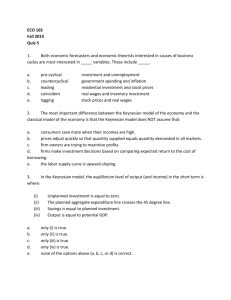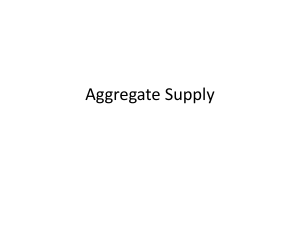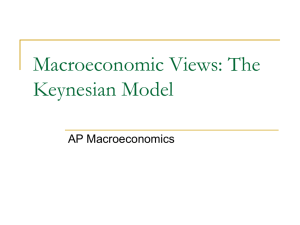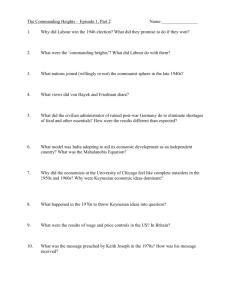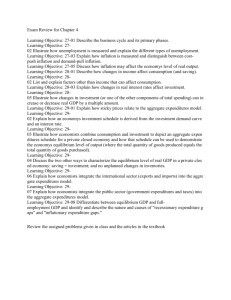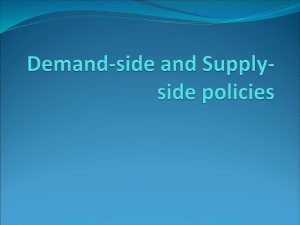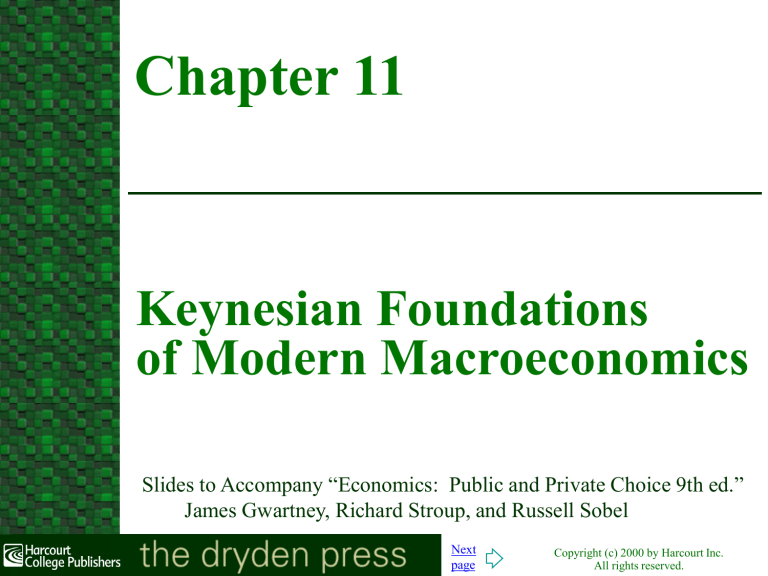
Chapter 11
Keynesian Foundations
of Modern Macroeconomics
Slides to Accompany “Economics: Public and Private Choice 9th ed.”
James Gwartney, Richard Stroup, and Russell Sobel
Next
page
Copyright (c) 2000 by Harcourt Inc.
All rights reserved.
“ I believe myself to be writing a book on
economic theory which will largely
revolutionize—not, I suppose, at once
but in the course of the next ten years—
the way the world thinks about economic
problems. ”
-- John Maynard Keynes
Jump to first page
Copyright (c) 2000 by Harcourt Inc.
All rights reserved.
1. Keynesian Explanations
of the Great Depression
Jump to first page
Copyright (c) 2000 by Harcourt Inc.
All rights reserved.
Keynesian Explanations
of the Great Depression
Keynesian economics developed during the
Great Depression (1930s).
Keynesian theory provided an explanation for
the severe and prolonged unemployment of the
1930s.
Keynes argued that wages and prices were
highly inflexible, particularly in a downward
direction. Thus, he did not think changes in
prices and interest rates would direct the
economy back to full employment.
Jump to first page
Copyright (c) 2000 by Harcourt Inc.
All rights reserved.
Keynesian Explanations
of the Great Depression
Keynesian View of Spending and Output:
-- Keynes argued that spending induced business
firms to supply goods & services. Thus, if
total spending fell, then business firms would
respond by cutting back production. Less
spending would thus lead to less output.
Jump to first page
Copyright (c) 2000 by Harcourt Inc.
All rights reserved.
2. The Basic
Keynesian Model
Jump to first page
Copyright (c) 2000 by Harcourt Inc.
All rights reserved.
The Basic Keynesian Model
Aggregate
Expenditures
=
Planned
Consumption
+
Planned
Investment
+
Planned
Government
Expenditures
+
Planned
Net
Exports
In the Keynesian model
as income expands, consumption increases,
but by a lesser amount than the increase in
income,
both planned investment and government
expenditures are independent of income, and,
planned net exports decline as income
increases.
Jump to first page
Copyright (c) 2000 by Harcourt Inc.
All rights reserved.
Aggregate Consumption Function
Planned Consumption
Expenditures
45º Line
(trillions of dollars)
12
Saving
C
9
6
Dis-saving
3
45º
3
6
9
12
Real
Disposable Income
(trillions of dollars)
The Keynesian model assumes that there is a positive relationship
between consumption and income.
However, as income increases, consumption increases by a smaller
amount. Thus, the slope of the consumption function (line C) is less
than 1 (less than the slope of the 45° line).
Jump to first page
Copyright (c) 2000 by Harcourt Inc.
All rights reserved.
Income and
Net Exports
Total Output
Planned Exports
Planned Imports
Planned Net Exports
(Real GDP In Billions)
(Billions)
(Billions)
(Billions)
$850
850
850
850
850
$650
700
750
800
850
$200
150
100
50
0
$7,600
7,900
8,200
8,500
8,800
Because exports are determined by income abroad,
they are constant at $850 billion.
Imports increase as domestic income expands.
Thus, planned net exports fall as domestic income
increases.
Jump to first page
Copyright (c) 2000 by Harcourt Inc.
All rights reserved.
3. Keynesian
Equilibrium
Jump to first page
Copyright (c) 2000 by Harcourt Inc.
All rights reserved.
Keynesian Equilibrium
In the Keynesian view, equilibrium occurs when:
Planned Aggregate
Expenditures
=
Current
Output
When this is the case:
businesses are able to sell the total
amount of goods & services that they
produce, and,
there are no unexpected changes in
inventories, so,
producers have no reason to either
expand or contract their output during
the next period.
Jump to first page
Copyright (c) 2000 by Harcourt Inc.
All rights reserved.
Keynesian Equilibrium
When
Total Aggregate
Expenditures
<
Current
Output
business firms will accumulate unplanned
additions to inventories that will cause them to
cut back on future output and employment.
When
Total Aggregate
Expenditures
>
Current
Output
inventories will fall and businesses will respond
with an expansion in output in an effort to
restore inventories to their normal levels.
Jump to first page
Copyright (c) 2000 by Harcourt Inc.
All rights reserved.
Keynesian Equilibrium
Keynesian equilibrium can occur at
less than full employment.
When it does, the high rate of
unemployment will persist into the
future.
Aggregate Demand is key to the
Keynesian model.
Keynes believed that weak aggregate
demand was the cause of the Great
Depression.
Jump to first page
Copyright (c) 2000 by Harcourt Inc.
All rights reserved.
An Example of Keynesian
Macroeconomic Equilibrium
Planned
Investment
+
Planned
Government
Expenditures Net Exports
Total
Output
(Real GDP)
Planned
Aggregate
Expenditures
Planned
Consumption
(1)
(2)
(3)
(4)
(5)
(6)
$7,900
8,050
8,200
8,350
8,500
$6,000
6,200
6,400
6,600
6,800
$1,700
1,700
1,700
1,700
1,700
$200
150
100
50
0
Expand
Expand
Equilibrium
Contract
Contract
$7,600
7,900
8,200
8,500
8,800
<
<
=
>
>
Tendency
Of Output
Recall that Planned Aggregate Expenditures equals the sum of Planned Consumption,
Planned Investment, Planned Government Expenditures, and Planned Net Exports.
In the Keynesian system, when total output is less than planned
aggregate expenditures, purchases exceed output and inventories
are depleted. Firms expand their output to rebuild their
inventories to regular levels.
When actual output is more than planned aggregate expenditures,
output exceeds purchases, and inventories accumulate. Firms
reduce their output to slow the accumulation of further inventory.
When planned aggregate expenditures equal Total Output, there
is Keynesian macroeconomic equilibrium.
Jump to first page
Copyright (c) 2000 by Harcourt Inc.
All rights reserved.
Aggregate Expenditures (AE)
Planned Aggregate
Expenditures
Equilibrium
(trillions of dollars)
(AE = GDP)
8.5
7.9
Output
45º
7.9
8.5
(Real GDP -trillions of $)
Aggregate expenditures will be equal to total output
for all points along the 45° line from the origin.
The 45° line maps out potential equilibrium levels
of output for the Keynesian model.
Jump to first page
Copyright (c) 2000 by Harcourt Inc.
All rights reserved.
Aggregate Expenditures
and Keynesian Equilibrium
Planned Aggregate
Expenditures
Equilibrium
(trillions of dollars)
(AE = GDP)
Unplanned
Increase in
Inventories
Now the previously
presented Planned
Aggregate Expenditures
data is introduced.
8.5
8.35
Unplanned
Reduction in
Inventories
AE = C + I + G + NX
8.05
7.9
Output
45º
7.9
8.5
(Real GDP -trillions of $)
At output levels below $8.2 trillion (for example 7.9) AE is above the 45°
line – expenditures exceed output and thus businesses sell more than they
currently produce, diminishing inventories. Businesses expand output.
At output levels above $8.2 trillion (for example 8.5) AE is below the 45°
line – output exceeds expenditures and thus businesses sell less than they
currently produce, increasing inventories. Businesses expand output.
Jump to first page
Copyright (c) 2000 by Harcourt Inc.
All rights reserved.
Aggregate Expenditures
and Keynesian Equilibrium
Planned Aggregate
Expenditures
Equilibrium
(trillions of dollars)
(AE = GDP)
AE = C + I + G + NX
8.5
8.35
8.2
Keynesian
Equilibrium
8.05
7.9
Full Employment
(Potential Output)
Output
45º
7.9
8.2
8.5
(Real GDP -trillions of $)
At that level of income where planned expenditures just equal
actual output, the Keynesian equilibrium exists. Here that
equilibrium exists at $8.2 trillion.
Note that full-employment for this example exists at $8.5 trillion.
In the Keynesian model equilibrium does not necessarily coincide
with full-employment.
Jump to first page
Copyright (c) 2000 by Harcourt Inc.
All rights reserved.
Shifts in Aggregate Expenditures
and Changes in Equilibrium Output
Equilibrium
Planned Aggregate
Expenditures
(AE = GDP)
AS
(trillions of dollars)
8.8
AE3
AE2
AE1
8.5
8.2
7.9
Full Employment
(Potential Output)
Output
45º
8.2
8.2
8.5
(Real GDP -trillions of $)
When equilibrium output is less than the economy’s capacity only an
increase in expenditures (a shift in AE) will lead to full employment output.
If consumers, investors, governments, or foreigners would spend more and
thereby shift AE to AE2, output would reach its full employment potential.
Once full employment is reached, further increases in AE, such as to AE3,
lead only to higher prices (nominal output expands along the dotted segment
of AE, real output will not).
Jump to first page
Copyright (c) 2000 by Harcourt Inc.
All rights reserved.
4. The Keynesian View
Can be Illustrated
Within the AD/AS
Framework
Jump to first page
Copyright (c) 2000 by Harcourt Inc.
All rights reserved.
The Keynesian View Illustrated
within the AD/AS Framework
When output is less the fullemployment, the primary impact of an
increase in aggregate demand will be
an increase in output.
When output is at or beyond the fullemployment level, the primary impact of
an increase in demand will be higher
prices.
Jump to first page
Copyright (c) 2000 by Harcourt Inc.
All rights reserved.
Keynesian Aggregate Supply Curve
Price
Level
SRAS
LRAS
Keynesian Range
P1
Full Employment
(Potential Output)
YF
Goods & Services
(real GDP)
The Keynesian model implies a 90°, angle-shaped SRAS curve that is
flat for outputs less than potential GDP (YF) -- because of downward
wage and price inflexibility.
This flat range is often referred to as the Keynesian range. Output
here is entirely dependent on the level of aggregate demand.
As the Keynesian model implies that real output rates beyond full
employment are unattainable, both the SRAS and LRAS curve are
vertical at potential output.
Jump to first page
Copyright (c) 2000 by Harcourt Inc.
All rights reserved.
AD / AS Presentation of the Keynesian Model
Price
Level
SRAS
e3
P3
P1 , P2
LRAS
e1
e2
AD3
AD1
Y1
YF
AD2
Goods & Services
(real GDP)
The diagram above illustrates the Polar implications of the
Keynesian model.
When output is less than capacity (for example Y1), an increase in
Aggregate Demand such as illustrated by the shift from AD1 to AD2
will expand output without increasing the price level (P2 = P1).
But, increases in demand beyond AD2, such as a shift to AD3, lead
only to a higher price level (P3).
Jump to first page
Copyright (c) 2000 by Harcourt Inc.
All rights reserved.
AD / AS Presentation of the Keynesian Model
Price
Level
LRAS
SRAS
P3
P2
P1
e3
e2
e1
AD2
AD1
Y1
YF Y3
AD3
Goods & Services
(real GDP)
The diagram above relaxes the assumptions of the model regarding
complete price and short-run output inflexibility beyond YF. The
SRAS curve now turns from horizontal to vertical more gradually.
Now an unanticipated increase in AD would lead:
Primarily to increases in output when output is below capacity (for
example beginning at AD1 with output Y1).
Primarily to increases in the price level when strong demand pushes
output beyond capacity (for example demand greater than AD2).
Jump to first page
Copyright (c) 2000 by Harcourt Inc.
All rights reserved.
Questions for Thought:
1. What determines the equilibrium rate of output
in the Keynesian model? What did Keynes
think had happened during the prolonged, high
level of unemployment of the Great Depression?
2. In the Keynesian model, what is the major
factor that causes the level of output and
employment to change?
Jump to first page
Copyright (c) 2000 by Harcourt Inc.
All rights reserved.
5. The Multiplier
Jump to first page
Copyright (c) 2000 by Harcourt Inc.
All rights reserved.
The Multiplier
The Multiplier:
-- The view that a change in autonomous
expenditures (e.g. investment) leads to an
even larger change in aggregate income.
An increase in spending by one party
increases the income of others. Thus, an
increase in spending can expand output by
a much larger amount.
The multiplier is the number by which the
initial change in spending is multiplied to
obtain the total amplified increase in income.
The size of the multiplier increases with the
marginal propensity to consume (MPC).
Jump to first page
Copyright (c) 2000 by Harcourt Inc.
All rights reserved.
The Multiplier
In evaluating the importance of the
multiplier, one should remember:
taxes and spending on imports will
dampen the size of the multiplier;
it takes time for the multiplier to work;
and,
the amplified effect on real output will
be valid only when the additional
spending brings idle resources into
production without price changes.
Jump to first page
Copyright (c) 2000 by Harcourt Inc.
All rights reserved.
The Multiplier Principle
Additional
Income
Additional
Consumption
(Dollars)
(Dollars)
Marginal
Propensity
To Consume
Round 1
Round 2
Round 3
Round 4
Round 5
Round 6
Round 7
Round 8
Round 9
Round 10
All Others
1,000,000
750,000
562,500
421,875
316,406
237,305
177,979
133,484
100,113
75,085
225,253
750,000
562,500
421,875
316,406
237,305
177,979
133,484
100,113
75,085
56,314
168,939
3/4
3/4
3/4
3/4
3/4
3/4
3/4
3/4
3/4
3/4
3/4
Total
4,000,000
3,000,000
3/4
Expenditure
Stage
For simplicity (here) it is assumed that all additions to income are either spent domestically or saved.
The multiplier concept is fundamentally based upon the proportion of
additional income that households choose to spend on consumption:
the marginal propensity to consume (here assumed to be 75% 3/4).
Here, a $1,000,000 injection is spent, received as payment, saved and
spent, received as payment, saved and spent … etc. … until . . .
effectively, $4 million is spent in the economy.
Jump to first page
Copyright (c) 2000 by Harcourt Inc.
All rights reserved.
A Higher MPC
Means a Larger Multiplier
SIZE OF
MPC
9/10
4/5
3/4
2/3
1/2
1/3
MULTIPLIER
10.0
5.0
4.0
3.0
2.0
1.5
As the MPC increases more and more money of every injection is spent
(and so received as payment and then spent again, received as payment
and spent again, etc.).
The effect is that for higher MPCs, higher multipliers result, specifically
the relationship follows this equation:
1
M = 1 - MPC
Jump to first page
Copyright (c) 2000 by Harcourt Inc.
All rights reserved.
6. The Keynesian view
of the Business Cycle
Jump to first page
Copyright (c) 2000 by Harcourt Inc.
All rights reserved.
Keynesian View
of the Business Cycle
Keynesians argue that a market economy, if left to
its own devices, is unstable and likely to experience
prolonged periods of recession.
According to the Keynesian view of the business
cycle, upswings and downswings tend to feed on
themselves.
During a downturn, business pessimism, declining
investment, and the multiplier principle combine to
plunge the economy further toward recession.
During an economic upswing, business and consumer
optimism and expanding investment interact with the
multiplier principle to propel the economy to an
inflationary boom.
The theory suggests that a market-directed economy,
left to its own devices, will tend to fluctuate between
economic recession and inflationary boom.
Jump to first page
Copyright (c) 2000 by Harcourt Inc.
All rights reserved.
Keynesian View
of the Business Cycle
Regulation of aggregate expenditures is the crux
of sound macroeconomic policy according to the
Keynesian view.
If we could assure aggregate expenditures large
enough to achieve capacity output, but not so
large as to result in inflation, the Keynesian view
implies that maximum output, full employment,
and price stability would be attained.
Jump to first page
Copyright (c) 2000 by Harcourt Inc.
All rights reserved.
7. Evolution of Modern
Macroeconomics
Jump to first page
Copyright (c) 2000 by Harcourt Inc.
All rights reserved.
Evolution of
Modern Macroeconomics
Major Insights of Keynesian Economics:
Changes in output, as well as in prices, play
a role in the macroeconomic adjustment
process, particularly in the short run.
The responsiveness of aggregate supply to
changes in demand will be directly related to
the availability of unemployed resources.
Fluctuations in aggregate demand are an
important potential source of business
instability.
Modern macroeconomics is a hybrid,
reflecting elements of both classical and
Keynesian analysis as well as some insights
drawn from other areas of economics.
Jump to first page
Copyright (c) 2000 by Harcourt Inc.
All rights reserved.
Questions for Thought:
1. What is the multiplier principle? What determines
the size of the multiplier? Does the multiplier
principle make it more or less difficult to stabilize
the economy? Explain.
2. Widespread acceptance of the Keynesian aggregate
expenditure (AE) model took place during and
immediately following the Great Depression. Can
you explain why? The aggregate expenditure model
declined in popularity when many economies
experienced both high rates of unemployment and
inflation during the 1970s. Was this surprising?
Jump to first page
Copyright (c) 2000 by Harcourt Inc.
All rights reserved.
End
Chapter 11
Jump to first page
Copyright (c) 2000 by Harcourt Inc.
All rights reserved.


